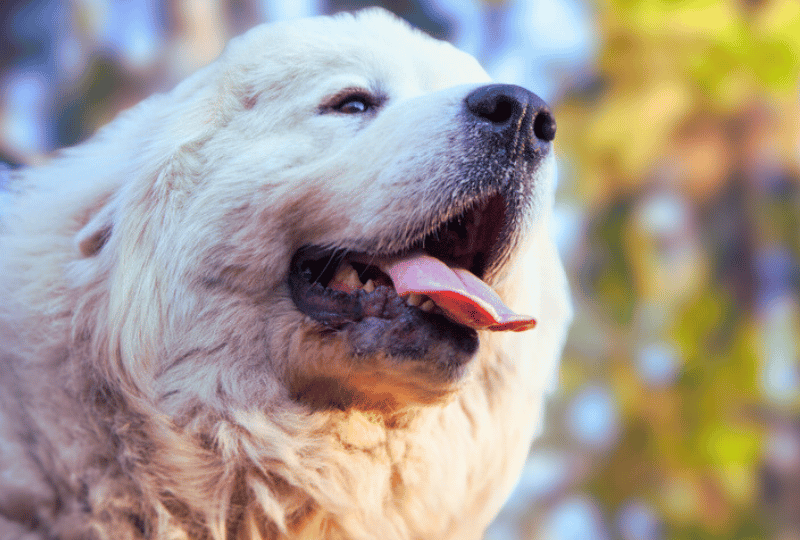Great Pyrenees are big, adorable mountain dogs. While these dogs were originally bred as livestock guardians, they’ve evolved to become well-loved family members. One of the saddest things about getting a dog is knowing that you’re probably going to outlive them. Saying goodbye to our furry friends is never easy, no matter what the circumstances.
The typical lifespan of a Great Pyrenees is about 10 – 12 years. That being said, some individuals may live longer than 12 years, and others may pass earlier. To give your pet the best chance at a long life make sure to keep a close eye on any potential medical issues.
In this article, we’ll talk about what the normal life expectancy is for Great Pyrenees. We’ll also talk about some of the most common healthy problems these dogs encounter. Finally, we’ll make some recommendations on how to ensure that your pup has the best chance of living a long, healthy life.
What Is The Typical Great Pyrenees Life Expectancy?
According to the American Kennel Club, the average lifespan for a Great Pyrenees is about 10-12 years.
Lifespans are a little backward for dogs. Often, smaller breeds are much longer lived than large breed dogs. Usually, in the animal kingdom, larger animals are usually longer lived than smaller animals. Take elephants for an example, these animals are huge and are still some of the longest-living mammals.
Even though it doesn’t make sense that smaller dogs live longer than larger dogs, it’s just a fact. 10 to 12 years is a pretty typical lifespan for a large breed dog. However, breed and lifestyle can make a huge impact on how long a dog will live.
Can a Great Pyrenees Live Longer Than 12 Years?
Great, Pyrenees can absolutely live longer than 12 years. 10 to 12 years is average so it’s definitely possible for a Great Pyrenees to live beyond their 12-year lifespan. Online, you can read accounts of people who had their great Pyrenees lived to be 16 years old.
Now, there’s no guarantee that you’re a great Pyrenees will live to be older than 12, and while some of the factors are controllable, others are not.
How Fast Do Great Pyrenees Grow?
Not only do Great Pyrenees have a short lifespan, but they also don’t grow very fast.
When compared with a smaller dog great Pyrenees take a long time to mature. Great Pyrenees aren’t considered to be adults until about two years of age. Since they’re so large, it takes longer for them to grow to their full potential. The difficult part about this is that if your Pyrenees only lives to be about 10 years old, your dog will be a puppy for 20% of their lives.
You can see in the video below how the 1-year-old Great Pyrenees still looks like a baby in many ways and definitely isn’t fully grown.
While we all love the puppy stage, there’s no denying it can be frustrating and difficult.
Common Great Pyrenees Health Problems That Can Impact Lifespan
Some of the best ways to ensure that your great Pyrenees lives, a long and healthy life are to identify health problems early on. Because of their breed and size, Great Pyrenees are prone to a few different medical issues. If you want your great Pyrenees to live for a long time, you’ll want to keep an eye on these from the time they’re a puppy.
Hip, Knee, Or Elbow Dysplasia
Many large dogs are prone to joint dysplasia which can affect how long they live.
Joint dysplasia describes a condition where a joint doesn’t fit properly into a socket. At its best, hip dysplasia may cause mild discomfort and at its worst can immobilize a dog. Large dogs are at a higher risk of hip, knee, and elbow dysplasia because of the amount of weight placed on their joints.
Genetics, breeding, obesity, inappropriate exercise, and poor diet can also lead to joint dysplasia.
Knowing that Great Pyrenees are more likely to have hip dysplasia than other dogs is important because you can take preventative measures when your Pyr puppy is young. For example, if you’re worried about your dog’s hips in the future, you should try to avoid letting them go up and down stairs for as long as possible. You can also make sure to get food that provides your dog with joint supplements like glucosamine.
Paying attention to joint issues early will help your Great Pyrenees live longer.
Osteosarcoma
Osteosarcomas are malignant bone tumors that can be incredibly painful.
Sadly, Great Pyrenees puppies are at higher risk than most dogs of getting bone cancer. Osteosarcomas are usually identified through swelling or limping in the affected limb. Bone tumors are treated by removal which usually means mutating one of your pup’s legs.
Luckily, many puppies do well with only three legs and can bounce back from this type of cancer. But, if your dog has to go through chemo at a young age, it might affect how long they live.
Gastric Dilation And Volvulus
Gastric dilation and volvulus (GDV) or bloat is an emergent health issue for large and deep-chested dogs.
GDV describes a condition where a dog’s stomach is full of gas and ends up twisting over itself. When the stomach twists, both the entrance and exit routes are blocked, creating an emergency. GDV requires surgical intervention to treat.
Although the exact cause of GDV is still not identified, it’s often observed in dogs weighing over 100 lbs with deep chests who are skinny and only eat one large meal per day.
Knowing that your Great Pyrenees is at risk for GDV should help you make some dietary choices to prevent that early on. Some ways to decrease the risk of GDV are to feed your dog two meals per day minimum and to include canned food in the diet. Because bloat is so common and so dangerous, Dr. Nita Patel explains that “In many clinics, pet parents have the option of getting the stomach tacked to the body wall (gastropexy) at the time of spay/neuter to prevent this from happening.”
Knee Cap Luxation
Traditionally, a knee cap or patellar luxation is something that was thought to primarily affect small dogs. Now, it’s been noted that some larger dog breeds, including Great Pyrenees, seem to be predisposed to this injury.
When a knee cap is luxated, it sits outside of the groove where it belongs when a dog’s leg is flexed. For some dogs, this can be a minor injury that repeatedly dislocated and relocates on its own throughout the day. For larger dogs, a patellar luxation usually means a limp or complete lameness in the affected leg.
If surgery is required to fix a luxation like this, the recovery process can be intense for large dogs. There isn’t really a way to prevent this condition but if a dog has had knee cap issues in the past, it shouldn’t be bred again in the future. These problems seem to be genetic and can obviously shorten the lifespan and reduce the quality of your pup’s life.
How To Increase The Lifespan Of Your Great Pyrenees
We’ve just covered some of the scariest health problems you might run into with your Great Pyrenees. There’s no guarantee that your Pyr will be affected by any of these things but they’re always important to keep in mind. Now, let’s talk about some of the things you can do to help your Pyrenees live a long life.
Provide A Healthy Diet
A balanced and healthy diet is one of the easiest ways to make sure your pet lives as long as possible. But how do you know if you’re feeding them anything to your dog?
There are 1 million different dog food options available for purchase. Labeling can be very misleading and qualities aren’t regulated very well. Make sure you’re giving your dog all the nutrients they need to thrive.
We recommend talking to your veterinarian and doing some research on your own. See what brands and types of food your vet recommends for a Great Pyrenees. Then, you can do a deep dive into each of the recommendations and see which ingredients are best for your furry friend.
Make Sure They Get Enough Exercise
Another part of keeping your dog’s cardiovascular system in tip-top shape is exercise.
Great Pyrenees need a minimum of about 40 minutes of low-intensity exercise per day. Since these dogs aren’t super active naturally, they don’t need high-intensity exercises. A simple walk around the park should satisfy the needs of these fluffy giants. Even though it doesn’t seem like much, exercise helps, your dog manage, obesity and stay mentally stimulated.
Take Them For Yearly Checkups
Nobody really likes to visit the veterinarian. Not only is it expensive for you but it might also scare your furry friend. That being said, getting at least a yearly check-up at your vet is super important.
A regular check-up can help you keep an eye on your dog’s overall health condition. Plus, if your dog starts to show any early signs of the diseases we mentioned above, you can keep a close eye on them. What’s great about an exam at the veterinarian is that if you do encounter any issues you can treat them right then and there.
Keep Their Teeth Clean
Dental disease is not talked about enough in canine health.
Dental disease is one of the most common issues seen in adult and geriatric dogs. It can be hard to brush the dog’s teeth, but if you weren’t keeping an eye on them, things can escalate quickly. Teeth can fracture or become infected without you ever knowing.
Sadly, dental disease is linked to cardiovascular disease. Dirty teeth may not seem like a big deal, but they can definitely shorten the lifespan of your pet. One of the best things that you can do for your dog is to try to brush their teeth.
Many dogs can be trained to accept toothbrushing but some might not be so tolerant. Luckily, great Pyrenees aren’t prone to dental disease, and chewing on a hard toy like a bone might be enough to keep their teeth clean.
Consider Getting A Mixed Breed Pyrenees
If you’re worried about the answer to the question “how long do Great Pyrenees live,” we have a solution for you!
10 – 12 years doesn’t seem long enough. One thing that is almost guaranteed to increase your Great Pyrenees lifespan is to not get a purebred Great Pyrenees. It sounds counterintuitive, we know. But there’s no denying that mixed-breed dogs live longer overall than purebred dogs. That’s because their genetics are much more balanced, and they’ve got the good traits from all of the breeds they’re mixed with.
Final Thoughts
It’s safe to say that Great Pyrenees don’t live long enough. Most people want to find ways to increase the 10-12 year lifespan if they can.
Luckily, there are plenty of things you can do to try to help your Pyr live longer. Keep an eye out early for common health problems of this breed. Make sure to keep up with yearly vet visits and provide a high-quality diet. Ensure that your dog gets adequate exercise every day and try to keep their teeth as clean as possible. Lastly, you can always try adopting a mixed breed Great Pyrenees that will have better genes than a purebred.
Hopefully, this article has answered all of your questions about how long Great Pyrenees live.


